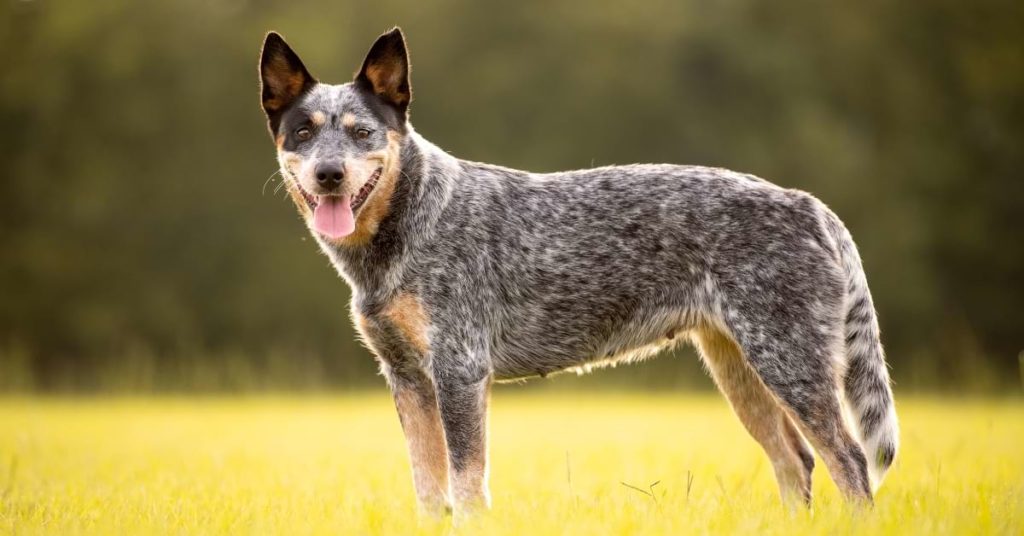The Blue Heeler Jack Russell Mix is a unique and increasingly popular hybrid mixed breed that combines the traits of the Australian Cattle Dog, also known as the Blue Heeler and the Jack Russell Terrier.
This breed is known for its energetic and intelligent personality, as well as its high level of activity and loyalty to its owners. However, owning a Blue Heeler Jack Russell Mix may only suit some, as this breed requires much attention, exercise, and training.
In this article, we will answer some of the most common questions about the Blue Heeler Jack Russell Mix to help you determine whether this breed is the right dog for you.
Brief overview of Blue Heeler Jack Russell Mix
| Other Names | Cattlejack, Jack Heeler, Cattle Jack Dog, Jack Russell Blue Heeler Mix |
| Purity | Crossbred |
| Purpose | Sporting or working dogs |
| AKC Recognition | No |
| Size | Small to medium |
| Weight | 20-35 pounds |
| Height | 14-18 inches |
| Colors | Blue and tan, white and black, white and tan, tricolor |
| Child friendliness | High |
| Training difficulty | Easy to train |
| Grooming upkeep | Minimal |
| Exercise needs | Very high |
| Health | Good |
| Lifespan | 13-16 years |
| Puppy cost | $500-$1,200 |
What is a Blue Heeler Jack Russell Mix?

The Blue Heeler Jack Russell Mix, often termed as Cattle Jack or Jack Heeler, is a captivating blend of the Jack Russell Terrier and the Australian Cattle Dog (Blue Heeler). This hybrid dog showcases traits from both its parent breeds, making it a unique and delightful addition to any dog-loving home.
Parent Breeds of Blue Heeler and Jack Russell Mix
To better understand what to expect from the mixed pups, one must delve into the individual characteristics of its parent breeds. With the Blue Heeler, also known as the Australian Cattle Dog, and the Jack Russell Terrier as the primary contributors to the genetic makeup of the Blue Heeler Jack Russell Mix, it is crucial to take a closer look at these breeds to understand the traits that the hybrid inherits from them.
Origins and history of Blue Heeler

The Blue Heeler, also called the Australian Cattle Dog (ACD), cattle dog, Halls Heeler, or Queensland Heeler, is a breed that has undergone a significant transformation over the years. Bred in Australia during the 1800s, the Blue Heeler was developed to assist in herding cattle. This task required a dog with remarkable stamina and the ability to withstand the country’s harsh climate.
The man behind the creation of this breed, George Elliott, utilized a crossbreeding approach to achieve his desired result. He crossbred the wild Dingo, a canine native to Australia, with various European sheep herding breeds, resulting in a new and sturdy pup ideal for cattle herding. This breed, which we now know as the Australian Cattle Dog or simply the Cattle Dog, is a testament to the power of crossbreeding in creating new dog breeds.
The Australian Cattle Dog comes in two shades: red and blue. The Blue Australian Cattle Dog, also known as the Blue Heeler, is the more popular due to its stunning coat and distinct differences from its wild Dingo ancestry. The intricacies of the Blue Heeler’s creation and its unique qualities make it a fascinating and captivating breed for dog enthusiasts and breeders alike.
Origins and history of Jack Russell Terrier

The history of the Jack Russell Terrier dates back to the 1800s when Reverend John Russell set out to create new hunting fox terrier breeds. His vision was to develop a small, fearless canine with an unyielding determination and boundless energy to pursue prey relentlessly.
To achieve his goal, Reverend John Russell embarked on a crossbreeding mission, experimenting with various terrier breeds, including the Bristol, Welsh, and Irish Terriers. The culmination of his efforts was the creation of the Jack Russell Terrier, a species that excelled in hunting and quickly became a favorite among fox hunters.
The breed was named after Reverend John Russell, and it quickly gained widespread popularity due to its unique characteristics. However, the Jack Russell Terrier’s success took time, as it underwent multiple hybridizations, resulting in a diverse genetic makeup and deviations from the breed’s standard.
Despite these complexities, the Jack Russell Terrier remains a beloved breed that has evolved and adapted to become the lively and energetic companion many pet owners know and love.
What Does a Blue Heeler Jack Russell Mix Look Like?
The Blue Heeler Jack Russell mix is a compact, athletic dog with a deep, muscular chest. Their ears might stand tall like a Blue Heeler’s or droop like a Jack Terrier’s. With expressive, often almond-shaped eyes, they exude alertness. The tail can be curved or straight, depending on the dominant gene.
Their double coat, resistant to weather, varies from smooth to rough. While many sport a mottled blue coat with tan markings, others might have patterns in white, black, or tan. Given their genetic diversity, each of these dogs is distinct, making them uniquely captivating.
Size, height, and weight
When it comes to size, height, and weight, a Blue Heeler Jack Russell mix usually falls between the parent breeds.
Typically, they have a slight to medium build, measuring 14 to 18 inches tall at the shoulder and weighing between 20 to 35 pounds. However, variations can occur, influenced by factors like diet, exercise, and genetics.
| Male | Female | |
| Size group | Small to medium | Small to medium |
| Height | 15-18 inches | 14-17 inches |
| Weight | 24-30 pounds | 20-28 pounds |
Coat colors and types
When it comes to coat colors and types, the Blue Heeler Jack Russell Mix is a delightful surprise package. While most have a short, smooth coat, some may inherit a medium-length rough jacket. Coat patterns vary wildly, from mottled blues to bicolor or tricolor with white, black, and tan markings.
Temperament and Personality
The Blue Heeler Jack Russell Mix is an unpredictable breed when it comes to personality. Your fur buddy might take after the Blue Heeler and be suspicious of other species, or it might resemble the Jack Russell, with stubborn and tenacious behavior.
Their bold and brave nature might make them challenging to train, and you’ll have to provide sufficient exercise to curb their energy. The upside is that they are highly devoted and loyal companions that will be by your side through thick and thin.
Is Blue Heeler Jack Russell Mix a good family dog?
Yes. The Blue Heeler Jack Russell Mix makes a great family dog due to their social and affectionate nature. They can also be helpful working dogs, eager to assist with farm or garden work.
- While they are high-energy dogs, they are not known to be troublemakers, but their stubborn streak can pose training challenges due to their independence.
- These dogs enjoy spending time outdoors, playing, and chasing small animals. Their high prey drive makes it essential for owners to have a fenced yard high enough to prevent jumping.
- Although they can be territorial and cautious of strangers, their tendency to bark is more likely than their inclination to bite. They may become aggressive towards other animals, like cats and dogs.
- However, families with young children may want to think twice before adopting a Blue Heeler Jack Russell mix because of their herding instinct, which could make them unsuitable around young children.
- Additionally, if these dogs don’t get enough exercise, they may resort to biting, nipping, and destructive chewing of household items.
Are Blue Heeler Jack Russell Mixes aggressive?
Yes, some Blue Heeler Jack Russell Mixes can be aggressive. However, not all display this trait. Their behavior depends on genetics, upbringing, and early socialization. If a Cattlejack senses danger, they might act protectively. But with early exposure to various people and animals, they can be friendly.
It’s crucial to train and socialize them from a young age. They’re intelligent, so with consistent guidance, they can learn good behavior.
Training

Training the Blue Heeler Jack Russell Mix presents challenges due to their independent nature, but early training is key. With their intelligence, they can learn a wide range of tasks. Socialization is crucial to mitigate territorial behavior. Consistent and patient training, along with positive reinforcement, yields the best results. Due to their prey drive, teaching them to restrain from chasing other animals is important.
Exercise Requirements
The Blue Heeler Jack Russell Mix is a high-energy breed requiring plenty of physical and mental stimulation to avoid unwanted behavior. Daily exercise is a must for these active and lively dogs. To satisfy their energy needs, owners should provide 30 minutes of intense exercise or 40 minutes of brisk walking daily. However, owners should also be mindful of the type of physical activity their dog can do since they have a herding instinct, which may make them unsuitable for specific actions.
Living Conditions
The Blue Heeler Jack Russell Mix is an energetic breed with plenty of space to roam around and burn off its high energy. A backyard is ideal for these canines to exercise and run to their hearts’ content.
Many pet owners opt for electronic dog doors to give their furry friends more freedom. With the installation of these doors, dogs can come and go as they please without requiring constant human supervision. These bright pet doors can even be programmed to lock during specific hours, ensuring safety and security.
However, living in small apartments might not be suitable for this breed. The Blue Heeler Jack Russell Mix is not designed for confined spaces and may become unhappy and restless in such environments. Providing them with ample space and opportunities for exercise and playtime is essential.
Grooming and Cleaning
Caring for your Blue Heeler Jack Russell Mix requires minimal grooming and maintenance, which is great news for pet owners!
- The breed has a short coat, meaning brushing your furry friend’s hair is necessary only 1 or 2 a week.
- The frequency of bathing should depend on when your pet needs it, so no strict schedule is required.
- It is important to regularly trim their nails to prevent them from becoming too long, which can be problematic for walking and cause a clicking sound on hard surfaces. If you see the tips of their nails extending beyond their paws, it’s time to grab the clippers and get to work.
- Dental care is also essential, so remember to brush your dog’s teeth at least 3 times a week using a toothbrush and toothpaste approved by your veterinarian. Maintaining good dental hygiene can help prevent dental problems and keep your pet’s teeth healthy and strong.
| Grooming need | Frequency |
| Hair brushing | Once a week. |
| Bathing | As and when required. |
| Ear cleaning | Once a week. |
| Tooth cleaning | Three times a week. |
| Haircutting | Not needed. |
| Nail trimming | Once or twice a month. |
Is a Blue Heeler Jack Russell Mix hypoallergenic?
No, the Blue Heeler Jack Russell Mix isn’t considered hypoallergenic. Hypoallergenic pets typically shed minimally and produce limited dander. However, this mix sheds moderately and can produce dander, making it a potential allergen source.
If someone in your home has allergies, it’s essential to consider this before adopting this breed.
Food and Diet
Feeding your Cattlejack is crucial to keep their energy levels high due to their dynamic nature. It’s essential to provide them with high-quality kibble or homemade food suitable for their age to ensure they get all the necessary nutrients.
While treats are necessary for training and rewarding good behavior, it’s essential to be mindful of how much is given. Keep treats to only 10% of their daily calorie intake to avoid unhealthy weight gain.
For growing puppies, four to five smaller meals are necessary to help with weight gain and development. As they grow, fewer but larger meals should be given.
If your Cattlejack suffers from allergies or food sensitivities, it’s best to consult a veterinarian for a specialized diet plan to avoid health issues.
Common Health Issues

Get ready for a burst of information because there are many health issues to watch in Blue Heeler Jack Russell mixes. Here are some of the most common ones:
1. Hip and elbow dysplasia
Hip and elbow dysplasia pose significant health risks for Blue Heeler Jack Russell Mix dogs, particularly larger breeds. Genetics and diet imbalance can contribute to this painful joint condition, often affecting hind legs. Maintaining a healthy diet and regular exercise regimen can mitigate risks. Vigilance in monitoring your dog’s mobility and seeking veterinary care at the first sign of discomfort is essential for early intervention.
2. Epilepsy
Blue Heeler Jack Russell mixes can inherit epilepsy, a condition marked by seizures due to brain electrical disruptions. Triggers like stress and feeding excitement may provoke attacks. While the exact cause of inherited epilepsy is unclear, awareness of this health issue is crucial for potential pet owners.
3. Lens luxation
Lens luxation, a hereditary issue, is prevalent in Blue Heeler Jack Russell mixes, where weakened ligaments lead to lens displacement. Timely surgical intervention is typically necessary to preserve vision and prevent complications. Pet owners should remain vigilant for symptoms like squinting, redness, or cloudiness in the eyes, promptly consulting a veterinarian if suspected.
4. Cushing’s Syndrome
Cushing’s Syndrome, stemming from adrenal gland hormone overproduction, manifests through increased thirst, appetite, weight gain, and other symptoms like muscle weakness and skin issues. Tumors or prolonged steroid use may trigger it. Due to symptom similarities with other conditions, precise veterinary diagnosis is essential. Treatment options, spanning medication to surgery, should be tailored in consultation with a vet for optimal management.
5. Deafness
Deafness is another health issue that a Cattlejack might inherit from their Jack Russell Terrier parent. The deafness can be congenital or due to toxic damage to the unborn puppy. The deafness can range from partial to complete and affect one or both ears.
6. Von Willebrand’s disease
Von Willebrand’s disease is a rare canine blood disorder that affects a dog’s ability to clot its blood. This disease is inherited from the dog’s parents and can result in severe bleeding, particularly after surgery or injury. Cattlejacks with this disease may show symptoms such as excessive bleeding, nosebleeds, or blood in their urine or stool. Veterinary care is crucial to manage the condition and prevent further complications.
7. Liver disease
The symptoms of liver disease in dogs are weight loss, diarrhea, vomiting, and loss of appetite. If you observe any of these symptoms, bringing your Cattlejack to the vet is crucial for a proper diagnosis. An infection, poor diet, exposure to toxic substances, or congenital disabilities can cause liver disease.
How Long Does Blue Heeler Jack Russell Mix Live?
The average lifespan of a healthy Jack Russell Blue Heeler Mix is 12 to 16 years, pretty close to how old their purebred parents live.
How Much Is a Blue Heeler Jack Russell Mix?
The price of a Blue Heeler Jack Russell Mix puppy is high compared to a purebred one. On average, you can pay around $800 to $1,200 for one of these hybrids. However, if the puppy’s parents come from champion bloodlines, the price can increase significantly.
Is Blue Heeler Jack Russell Mix The Right Dog For Me?
The Blue Heeler Jack Russell mix is a commendable dog breed, boasting favorable characteristics. Intelligent, active, and loyal are just a few of the many positive traits of this breed. While not known for their overtly affectionate nature, Cattlejacks are exceptionally dedicated to their owners.
However, it’s important to note that this breed may not be the ideal choice for inexperienced owners, given their high energy levels. Similarly, families with young children may want to reconsider owning this breed due to the potential risk of injury.
On the other hand, a Jack Heeler mix could be the perfect companion for you if you’re a single adult or a family with older kids. Prepare for a lifetime of adventure and cherished memories with this spirited and tenacious breed.
List of dogs that are similar to Blue Heeler Jack Russell Mix
- Mini Blue Heeler
- Blue Heeler-Rat Terrier Mix
- Blue Heeler-Chihuahua Mix
- Blue Heeler-Corgi Mix
- Jack Russell-Chihuahua mix
- Jack Russell-Lab mix
- Jack Russell-Pomeranian mix
- Jack Russell-Pug mix
- Jack Russell-Beagle Mix
- How Long Do Jack Russells Live?
Frequently Asked Questions
Do Blue Heeler Jack Russell Mixes Shed?
Yes, they do shed. Blue Heeler Jack Russell mixes have short double coats that can shed occasionally. Regular brushing helps maintain a healthy, shiny coat by distributing natural oils and preventing matting and dirt accumulation.
It’s especially important to groom them during seasonal changes to minimize excessive shedding.
Conclusion
In conclusion, the Blue Heeler Jack Russell Mix is a breed that offers a unique combination of energy, intelligence, and loyalty. However, it is essential to consider whether this breed is right for you before bringing one into your home.
By understanding their shedding habits, temperament, cost, and other factors, you can decide whether the Blue Heeler Jack Russell Mix is the right dog for you. If you are willing to provide the necessary attention, exercise, and training, this breed can make a wonderful and loving companion for years.

Pingback: Blue Heeler Husky Mix: Interesting Facts You Need to know 2023
Pingback: Blue Heeler Chihuahua Mix: Revealing Hidden Wonders 2023
Pingback: Catahoula Blue Heeler Mix: Revealing Hidden Wonders 2023
Pingback: Blue Heeler Rat Terrier Mix: Revealing Hidden Wonders 2023
Pingback: Rottweiler Blue Heeler Mix: Dive into the Interesting World 2023
Pingback: How Long Do Jack Russells Live? Nurturing a Lifetime 2023
Pingback: Jack Russell Lab Mix: Boundless Energy Unleashed 2024
Pingback: Mini Blue Heeler: Interesting World Of Your Dog 2024
Pingback: Jack Russell Chihuahua Mix: Heartwarming Magic! 2024
Pingback: Jack Russell Pomeranian Mix: Discover the Adorable Breed 2024
Pingback: Jug Dogs: A Perfect Blend of Two Beloved Breeds 2024
Pingback: Beagle Jack Russell Mix: Energy and Unbreakable Loyalty 2024